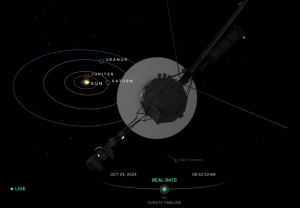Hey there, have you ever wondered about that little spacecraft zipping through the stars, still chatting with us back on Earth after all these years? I’m talking about Voyager 1, the plucky probe that’s been out there since 1977. It’s now in interstellar space, far beyond our solar system, and yes, it’s still sending data. Let’s dive into this amazing story, like I’m telling it to you over a cup of tea.
The Epic Journey of Voyager 1
Voyager 1 launched on September 5, 1977, from Cape Canaveral, Florida. It was part of NASA’s Voyager program to explore the outer planets. The probe flew by Jupiter in 1979 and Saturn in 1980, snapping incredible photos and gathering data that changed how we see our solar system.After that, it headed out towards the edge of the heliosphere, the bubble around our sun. In 2012, it became the first human-made object to enter interstellar space. That’s the space between stars, filled with cosmic rays and plasma from other suns.
Key Milestones
- 1977: Launch.
- 1979: Jupiter flyby, discovered active volcanoes on Io.
- 1980: Saturn flyby, detailed rings and moons.
- 1990: Famous Pale Blue Dot photo of Earth from 6 billion km away.
- 2012: Enters interstellar space.
- 2025: Still active, now about 167 AU from Earth (1 AU is the Earth-Sun distance).
How Voyager 1 Sends Data from So Far Away
This is the cool part. Voyager 1 is over 24 billion kilometres from Earth, but it still talks to us. How? It uses a radio system called the Deep Space Network (DSN), a set of huge antennas around the world run by NASA.The probe has a 3.7-metre antenna dish that beams signals back. It transmits at 23 watts, but by the time the signal reaches Earth, it’s weaker than a billionth of a billionth of a watt. That’s fainter than a fridge light seen from the moon!Normally, it uses X-band radio waves for clear data. But in late 2024, there was a glitch, so they switched to an old S-band transmitter from 1981. The data rate is slow, about 160 bits per second for science info, like downloading a photo over dial-up.Engineers at NASA’s Jet Propulsion Lab fix issues by sending commands that take 23 hours each way to travel. It’s like texting someone on another planet with massive delay.Did You Know?
Voyager 1 carries a Golden Record with sounds and images from Earth, in case aliens find it. It’s like a time capsule in space.Current Status in 2025
As of August 2025, Voyager 1 is going strong at 48 years old. It’s at about 167 AU, speeding at 17 km per second. Power comes from radioisotope thermoelectric generators (RTGs), which are fading but should last until around 2030.They turned off the Cosmic Ray Subsystem in February 2025 to save power. Active instruments include:- Low-Energy Charged Particles (LECP): Measures particles from stars.
- Magnetometer (MAG): Checks magnetic fields.
- Plasma Wave Subsystem (PWS): Listens to plasma waves.
In May 2025, they revived backup thrusters for better pointing. And it’s set to hit one light-day away in November 2026.
Specifications
| Aspect | Details |
| Launch Date | September 5, 1977 |
| Mass | 825 kg |
| Power Source | RTGs (plutonium-238) |
| Current Distance | ~167 AU (2025) |
| Speed | 17 km/s |
| Data Rate | ~160 bps for science |
| Antenna | 3.7 m high-gain |
| Expected End | Around 2030 |
Pros and Cons of the Voyager 1 Mission
Pros:
- Unmatched longevity: Still working after 48 years.
- Groundbreaking discoveries: Volcanoes on Io, details on Saturn’s rings.
- Cost-effective: Billions of km on a 1970s budget.
- Inspires generations: Shows what humans can achieve.
Cons:
- Aging tech: Frequent glitches, like the 2023-2024 computer issue.
- Limited power: Instruments shutting down one by one.
- Slow data: Takes days to get a small file.
- No return: It’s a one-way trip.
Highlights
- First to interstellar space.
- Farthest human-made object.
- Still sending data on cosmic rays and magnetic fields.
Quotes
“Voyager 1 is a testament to human ingenuity,” says Suzanne Dodd, Voyager project manager at JPL. “It’s like an old friend that keeps surprising us.”(Paraphrased from NASA updates.)Reviews
Experts rave about it. A Wikipedia entry calls it “the most productive scientific mission ever.” On Reddit, users marvel at how it transmits such weak signals. Space.com notes the team’s clever fixes for glitches.Key Takeaways
- Voyager 1 proves tech from the 70s can last decades.
- Data from interstellar space helps understand the universe.
- NASA’s DSN is key to long-distance space comms.
- The mission will end soon, but its legacy lives on.
Conclusion
Voyager 1’s story is one of endurance and wonder. From planetary flybys to probing the stars, it’s sent back knowledge that’s priceless. As it fades, let’s celebrate what it’s done. Who knows, maybe it’ll inspire the next big mission. What do you think?FAQ
Q: How far is Voyager 1 now? A: About 167 AU, or 25 billion km.Q: When will it stop sending data? A: Expected around 2030, when power runs out.Q: What data does it send? A: Info on particles, magnetic fields, and plasma waves in interstellar space.Q: Can we still control it? A: Yes, but commands take 46 hours round-trip.Poll
Do you think humans will launch another probe like Voyager soon?- Yes
- No
- Maybe



